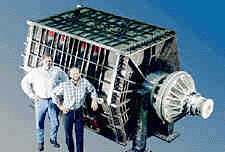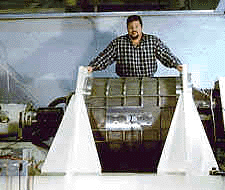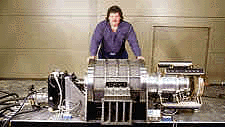
F = i x B (see diagram A)
(The equation at the bottom of Diagram A
has all of its variables in vector form)

In diagram A the blue arrow represnts the resultant force
direction vector, the red arrows represent the current direction vector
and the green arrow represents the
magnetic field direction vector. As you can see
the magnetic field that occurs due to the current between the rails is
directed between the rails, into the page
and normal or perpendicular to the direction of the current.
And the resultant force is directed down the rails and normal to the current
as well normal to the direction of
the magnetic field. If you use the right hand rule
you can see that the cross product between the the current (i) and the
magnetic field (B) is indeed directed downward along the rails.
Producing a magnetic field and thus a force large enough
to accelerate the projectile to the desired speeds, which in theory are
only limited
by the speed of light , requires an enormous amount of
current. However, this current does not have to be maintained for very
long. What is needed is a sharp pulse of a
large amount of current. One that is equal to anywhere
from 1 to 3 MA. To get an idea of how large a current this is, all it takes
to kill the human body is a current of about
.15 Amps or higher. On average, a rail gun will
draw 1,000,000 Amps. Thats an order of 7 magnitudes larger!! This should
impress you. To accomplish this task most
rail guns uses either capcitors, inductors, or
a compulsator. A compulsators (compensated pulse alternator) allows
for a huge amounts of current to be drawn repeatedly,
which means you can fire the rail gun more than once.
Compulsators have been in development since the mid 80's. Currently
at CEM their most powerful compulsator
has a peakoutput rating of 6kV, 3MA, 230MJ of stored
energy, and 9 shot repetitive firing capability. (It is pictured first
on the left below)
Here are a some pictures
of various compulsators:



To learn more about compulsators or rail guns visit CEM's site : CEM's rail gun page